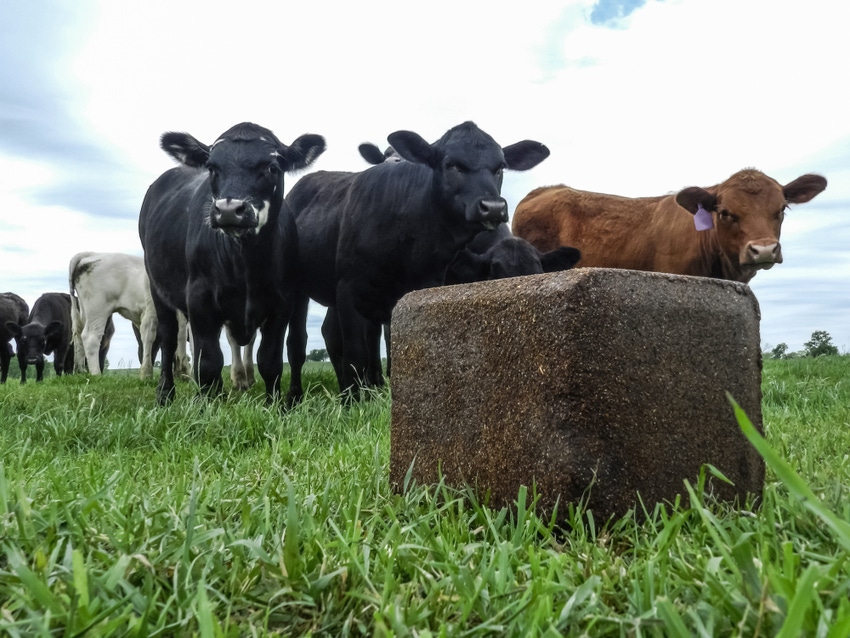What makes a ‘good complete’ mineral?
One perfect recipe for a mineral that will meet the needs of all cattle throughout the year does not exist.
August 28, 2023

Dr. Katie VanValin, University of Kentucky Extension
You’ve probably heard it a dozen times, “Make sure you put out a good complete mineral,” but what does this mean? Like many aspects of beef production, one perfect recipe for a mineral that will meet the needs of all cattle throughout the year does not exist. A good mineral is a product that can provide supplemental minerals in a form and source that allow cattle to consume enough minerals to prevent deficiencies. Unfortunately, not every mineral product on the shelves at the local farm store will meet this definition. Here are a few considerations when looking for a “good” mineral.
The first thing to consider is the form of mineral. The form typically refers to how the mineral is delivered to the cattle and includes blocks, loose free-choice minerals, loose minerals for mixing in feed, or injectables. While blocks continue to be a popular choice, these products are typically 95-99% salt. These products are often missing minerals such as calcium and phosphorus, and even when trace minerals such as copper, zinc, or selenium are included, the concentrations are so low that cattle cannot consume enough of the product for this form of supplementation to be effective. Injectable mineral products are an effective method of delivering a dose of minerals quickly. However, this form of mineral supplementation does not contain all recommended supplemental minerals and shouldn’t be used as a complete mineral program. When cattle are on feed, selecting a loose mineral that has been formulated to be mixed directly into the feed can be a convenient and effective method of mineral supplementation. For cattle on pasture, a loose free-choice mineral will typically be the best form of mineral supplementation to meet requirements for all supplemental minerals.
While mix-in or free-choice minerals are effective forms of mineral supplementation, a closer look at the mineral tag can allow you to select the product that is both cost-effective and meets the needs of your herd. The guaranteed analysis section of the mineral tag provides the concentration of selected minerals included in the supplement. One must look at the ingredient section for a complete list of included minerals. However, if it is not listed under the guaranteed analysis, the concentration of a specific mineral is unknown. When comparing two mineral products of the same form, be sure to look at the target intake that the mineral was formulated for. The target intake is listed in the directions section of the tag. If one mineral was formulated for a daily intake of 3 ounces (oz.) and another product formulated for 4 oz., the 3 oz. product may look like it contains more minerals, but this is not a fair comparison. Be careful not to compare apples to oranges.
It is also important to consider the source of the minerals in the supplement. The source refers to the kind of each individual mineral included in the mix and can be determined by looking at the ingredients list. Some mineral sources are more “bioavailable” than others. When a mineral source is more bioavailable, more of the mineral consumed can be used by the animal. Typically, inorganic sources of minerals are used in all mineral supplements. However, organic, chelated, or hydroxy sources of some minerals may also be included as these sources are often more bioavailable. When cattle are at risk of developing a deficiency for a specific mineral, looking for a mineral that includes more bioavailable sources may be advantageous. In the Southeast, cattle tend to be at risk for developing copper and selenium deficiencies, whereas manganese deficiencies, for example, would be rare. Thus, looking for a mineral that includes more bioavailable sources of copper (copper amino acid complex, basic copper chloride, copper lysine, etc.) and selenium (selenium yeast) is an important consideration when selecting a “good” mineral. Often mineral supplements will include multiple sources of a single mineral, and it is impossible to tell from a mineral tag alone how much of the mineral is being supplied from each source. This information can be gained by asking your feed dealer or nutritionist.
Consider what else can be provided in the mineral supplement. The mineral can effectively deliver feed additives such as ionophores, ingredients to manage flies or antibiotics. The efficacy of these added ingredients and the mineral supplementation program relies heavily on mineral intake. All mineral supplements are formulated to be consumed at a target rate. For free-choice supplements, this is typically 2-4 oz. For a good mineral to work well, target intakes should be met. A 50 lb. bag of mineral with a target intake of 3 oz. should last 30 cows for about 8 days.
Remember that what might make a good mineral for a producer in the western United States may not be the best option for a producer in the Southeast. Also, specific mineral needs or additive needs may change with the time of year and stage of production. For example, it is recommended that lactating cows at risk of developing grass tetany consume a high-magnesium mineral. For help understanding the mineral requirements of cattle in your local area and to discuss what a “good” mineral looks like for your herd, reach out to your local Extension office.
You May Also Like


.png?width=300&auto=webp&quality=80&disable=upscale)
